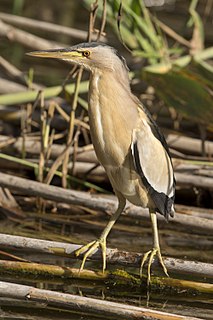
Hemidactylus is a genus of the common gecko family, Gekkonidae. It has 168 described species, newfound ones being described every few years. These geckos are found in all the tropical regions of the world, extending into the subtropical parts of Africa and Europe. They excel in colonizing oceanic islands by rafting on flotsam, and are for example found across most of Polynesia. In some archipelagoes, cryptic species complexes are found. Geckos like to live in and out of houses. They have been introduced to Australia.

The little gull, is a small gull that breeds in northern Europe and across the Palearctic. The genus name Hydrocoloeus is from Ancient Greek hydro, "water", and koloios, a sort of web-footed bird. The specific minutus is Latin for "small".

The little bittern or common little bittern is a wading bird in the heron family, Ardeidae. Ixobrychus is from Ancient Greek ixias, a reed-like plant and brukhomai, to bellow, and minutus is Latin for "small".

Gekkoninae is a diverse subfamily of the family Gekkonidae, geckos. It has the most species and genera — over 850 species in 30 genera. Hemidactylus and Cyrtodactylus together account for 185 species.

The poor cod, Trisopterus minutus, is a temperate marine fish belonging to the cod family (Gadidae). It is red brown in colour and has a pronounced chin barbel. It may grow up to a length of 40 cm. It is usually found in small shoals at depths between 10 and 300 metres on muddy or sandy bottoms. Its distribution spans the eastern Atlantic, from Norwegian coasts to Portugal and along the Atlantic coast of Morocco; also in the Mediterranean. Spawning takes place towards the end of winter. They are often regarded as a mini species and are commonly confused with pouting as they have a similar appearance. They are often seen as a menace for anglers and have little commercial value and so are not currently at any risk of extinction.

The harvest mouse is a small rodent native to Europe and Asia. It is typically found in fields of cereal crops, such as wheat and oats, in reed beds and in other tall ground vegetation, such as long grass and hedgerows. It has reddish-brown fur with white underparts and a naked, highly prehensile tail, which it uses for climbing. It is the smallest European rodent; an adult may weigh as little as 4 grams (0.14 oz). It eats chiefly seeds and insects, but also nectar and fruit. Breeding nests are spherical constructions carefully woven from grass and attached to stems well above the ground.

Micromys is a genus of small rodents in the subfamily Murinae. The genus, which is not closely related to any other murine genus, contains two living species: the widespread Eurasian harvest mouse of much of Europe and Asia; and the more restricted Micromys erythrotis of Vietnam, southern China, and perhaps nearby regions. Fossils of Micromys date back to the Late Miocene and include at least 10 extinct species, which form several lineages.

The black noddy or white-capped noddy is a seabird from the family Laridae. It is a medium-sized species of tern with black plumage and a white cap. It closely resembles the lesser noddy with which it was at one time considered conspecific. The black noddy has slightly darker plumage and dark rather than pale lores.

The Eurasian pygmy shrew, often known simply as the pygmy shrew, is a widespread shrew of northern Eurasia.

Hemidactylus brookii, commonly known as Brooke's house gecko or spotted house gecko, is a widespread species of gecko.

The Indo-Pacific gecko also known as Garnot's house gecko, the fox gecko, or the Assam greyish brown gecko, is a species of gecko found in India, the Philippines, Southeast Asia, Australia, and throughout Polynesia. Adults are about 4 to 5 in in total length. They are seen as dark gray or brown with light markings in daylight and a pale, translucent colour at night. The belly is orange or yellow. The head has a long, narrow snout, hence the name fox gecko. The flattened tail has a row of spiny scales on the lateral edges. The species is parthenogenic – all individuals are female and lay eggs that hatch without requiring male fertilisation.

The Mediterranean house gecko is a type of house gecko common to the Mediterranean area which has spread to many parts of the world. It is commonly referred to as the Turkish gecko as represented in its Latin name and also as the moon lizard because it emerges in the evening.

The common house gecko, is a gecko native to Southeast Asia. It is also known as the Asian house gecko, Pacific house gecko, wall gecko, house lizard, or moon lizard.

The Mount Sinai gecko is a species of lizard in the family Gekkonidae. The species is endemic to Egypt.

The lesser tube-nosed bat is a species of megabat in the family Pteropodidae. It is native to two of the Maluku Islands in northern Indonesia.

The minute fruit bat(Cynopterus minutus) is a species of megabat within the family Pteropodidae. It is found in Sumatra, Java, Borneo and Sulawesi.
Hemidactylus bouvieri, also known as Bouvier's leaf-toed gecko or Cape Verde leaf-toed gecko, is a species of gecko in the family Gekkonidae. The species is endemic to the Cape Verde Islands and is listed as critically endangered. It has been found on the islands of São Vicente, Santo Antão, Santa Luzia, São Nicolau, Santiago and Ilhéu Raso.













